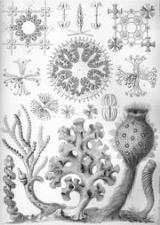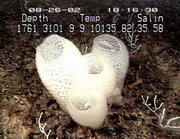
Hexactinellid
Encyclopedia
Hexactinellid sponges are sponges with a skeleton
made of four- and/or six-pointed siliceous spicules, often referred to as glass sponges. They are usually classified along with other sponges in the phylum Porifera, but some researchers consider them sufficiently distinct to deserve their own phylum, Symplasma.
waters.
They are more-or-less cup-shaped animals, ranging from 10 to 30 cm (3.9 to 11.8 in) in height, with sturdy lattice-like internal skeletons made up of fused spicules of silica. The body is relatively symmetrical, with a large central cavity that, in many species, opens to the outside through a sieve formed from the skeleton. Unlike other sponges, they tend to be present as individuals, rather than forming large fused colonies. They are generally pale in colour.
Much of the body is composed of syncitia, extensive regions of multinucleate
cytoplasm
. In particular, the epidermal cells of other sponges are absent, being replaced by a syncitial net of amoebocytes, through which the spicules penetrate. Unlike other sponges, they do not possess the ability to contract.
One ability they possess is a unique system for rapidly conducting electrical impulses across their bodies, making it possible for them to respond quickly to external stimuli. Glass sponges like "Venus' Flower Basket
" have a tuft of fibers that extends outward like an inverted crown at the base of their skeleton. These fibers are 50 to 175 mm (2 to 6.9 in) long and about the thickness of a human hair. They work as optical fiber
s somewhat similar to those used in modern telecommunication networks.
Glass sponges are different from other sponges in a variety of other ways. For example, most of the cytoplasm is not divided into separate cells by walls but forms a syncytium or continuous mass of cytoplasm with many nuclei (e.g., Reiswig and Mackie, 1983). These creatures live for a very long time, but the exact age is hard to measure; one study based on modelling gave an estimated age of a specimen of Scolymastra joubini as 23,000 years, which is thought impossible, but is the basis for a listing of ~15,000 years in the AnAge Database.
These creatures live for a very long time, but the exact age is hard to measure; one study based on modelling gave an estimated age of a specimen of Scolymastra joubini as 23,000 years, which is thought impossible, but is the basis for a listing of ~15,000 years in the AnAge Database.
The shallow water occurrence of hexactinellids is rare world wide. In the Antarctic two species occur as shallow as 33 meters under the ice. In the Mediterranean one species occurs as shallow as 18 meters in a cave with deep water upwelling (Boury-Esnault & Vacelet (1994)
off the coast of British Columbia
and Washington State, which are studied in the Sponge Reef Project
.
or late Neoproterozoic
. They are fairly common relative to demosponges as fossils, but this is thought to be, at least in part, because their spicules are sturdier than spongin
and fossilize better.
Like almost all sponges, the hexactinellids draw water in through a series of small pores by the whip like beating of a series of hairs or flagella in chambers which in this group line the sponge wall. (Sponge Gardens)
The class is divided into six orders, in two subclasses:
Class Hexactinellida
Skeleton
The skeleton is the body part that forms the supporting structure of an organism. There are two different skeletal types: the exoskeleton, which is the stable outer shell of an organism, and the endoskeleton, which forms the support structure inside the body.In a figurative sense, skeleton can...
made of four- and/or six-pointed siliceous spicules, often referred to as glass sponges. They are usually classified along with other sponges in the phylum Porifera, but some researchers consider them sufficiently distinct to deserve their own phylum, Symplasma.
Biology
Glass sponges are relatively uncommon and are mostly found at depths from 450 to 900 m (1,476.4 to 2,952.8 ft) although the species Oopsacas minuta has been found in shallow water, while others have been found much deeper. They are found in all oceans of the world, although they are particularly common in AntarcticAntarctic
The Antarctic is the region around the Earth's South Pole, opposite the Arctic region around the North Pole. The Antarctic comprises the continent of Antarctica and the ice shelves, waters and island territories in the Southern Ocean situated south of the Antarctic Convergence...
waters.
They are more-or-less cup-shaped animals, ranging from 10 to 30 cm (3.9 to 11.8 in) in height, with sturdy lattice-like internal skeletons made up of fused spicules of silica. The body is relatively symmetrical, with a large central cavity that, in many species, opens to the outside through a sieve formed from the skeleton. Unlike other sponges, they tend to be present as individuals, rather than forming large fused colonies. They are generally pale in colour.
Much of the body is composed of syncitia, extensive regions of multinucleate
Multinucleate
Multinucleate cells have more than one nucleus per cell, which is the result of nuclear division not being followed by cytokinesis. As a consequence, multiple nuclei share one common cytoplasm. This can be the consequence of a disturbed cell cycle control Multinucleate (also multinucleated,...
cytoplasm
Cytoplasm
The cytoplasm is a small gel-like substance residing between the cell membrane holding all the cell's internal sub-structures , except for the nucleus. All the contents of the cells of prokaryote organisms are contained within the cytoplasm...
. In particular, the epidermal cells of other sponges are absent, being replaced by a syncitial net of amoebocytes, through which the spicules penetrate. Unlike other sponges, they do not possess the ability to contract.
One ability they possess is a unique system for rapidly conducting electrical impulses across their bodies, making it possible for them to respond quickly to external stimuli. Glass sponges like "Venus' Flower Basket
Venus' Flower Basket
The Venus' Flower Basket, or Euplectella aspergillum is a hexactinellid sponge in the phylum Porifera inhabiting the deep ocean. In traditional Asian cultures, this particular sponge was given as a wedding gift because the sponge symbiotically houses two small shrimp, a male and a female, who live...
" have a tuft of fibers that extends outward like an inverted crown at the base of their skeleton. These fibers are 50 to 175 mm (2 to 6.9 in) long and about the thickness of a human hair. They work as optical fiber
Optical fiber
An optical fiber is a flexible, transparent fiber made of a pure glass not much wider than a human hair. It functions as a waveguide, or "light pipe", to transmit light between the two ends of the fiber. The field of applied science and engineering concerned with the design and application of...
s somewhat similar to those used in modern telecommunication networks.
Glass sponges are different from other sponges in a variety of other ways. For example, most of the cytoplasm is not divided into separate cells by walls but forms a syncytium or continuous mass of cytoplasm with many nuclei (e.g., Reiswig and Mackie, 1983).

The shallow water occurrence of hexactinellids is rare world wide. In the Antarctic two species occur as shallow as 33 meters under the ice. In the Mediterranean one species occurs as shallow as 18 meters in a cave with deep water upwelling (Boury-Esnault & Vacelet (1994)
Reefs
The sponges form reefsSponge reef
Sponge reefs serve an important ecological function as habitat, breeding and nursery areas for fish and invertebrates. The reefs are currently threatened by the fishery, offshore oil and gas industries[3,4]...
off the coast of British Columbia
British Columbia
British Columbia is the westernmost of Canada's provinces and is known for its natural beauty, as reflected in its Latin motto, Splendor sine occasu . Its name was chosen by Queen Victoria in 1858...
and Washington State, which are studied in the Sponge Reef Project
Sponge Reef Project
The Sponge Reef Project is a binational scientific project between Germany and Canada to study the sponge reefs off British Columbia, Canada, reefs formed by sponges of the Hexactinellid family....
.
Classification
The earliest known hexactinellids are from the earliest CambrianCambrian
The Cambrian is the first geological period of the Paleozoic Era, lasting from Mya ; it is succeeded by the Ordovician. Its subdivisions, and indeed its base, are somewhat in flux. The period was established by Adam Sedgwick, who named it after Cambria, the Latin name for Wales, where Britain's...
or late Neoproterozoic
Neoproterozoic
The Neoproterozoic Era is the unit of geologic time from 1,000 to 542.0 ± 1.0 million years ago. The terminal Era of the formal Proterozoic Eon , it is further subdivided into the Tonian, Cryogenian, and Ediacaran Periods...
. They are fairly common relative to demosponges as fossils, but this is thought to be, at least in part, because their spicules are sturdier than spongin
Spongin
Spongin, a modified type of collagen protein, forms the fibrous skeleton of most organisms among the phylum Porifera, the sponges. They are secreted by sponge cells known as spongocytes...
and fossilize better.
Like almost all sponges, the hexactinellids draw water in through a series of small pores by the whip like beating of a series of hairs or flagella in chambers which in this group line the sponge wall. (Sponge Gardens)
The class is divided into six orders, in two subclasses:
Class Hexactinellida
- Subclass Amphidiscophora
- Order Amphidiscosida
- Subclass HexasterophoraHexasterophoraHexasterophora are sponges, a subclass in the class Hexactinellida. The Hexasterophora first appeared in the Ordovician and is separated into five recent orders, including the Lyssacinosa, the Hexactinosa, and the Lychniscosa, all of which have living representatives in the seas...
- Order Aulocalycoida
- Order Hexactinosa
- Order Lychniscosa
- Order LyssacinosaLyssacinosaLyssacinosa is an order of glass sponges belonging to the subclass Hexasterophora. These sponges can be recognized by the parenchymal spicules usually being unconnected, unlike in other sponges in the subclass where the spicules form a more or less tightly connected skeleton.-References:*...

